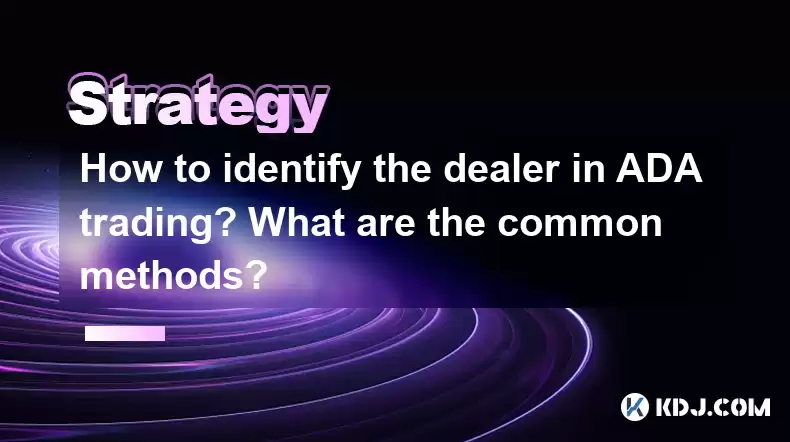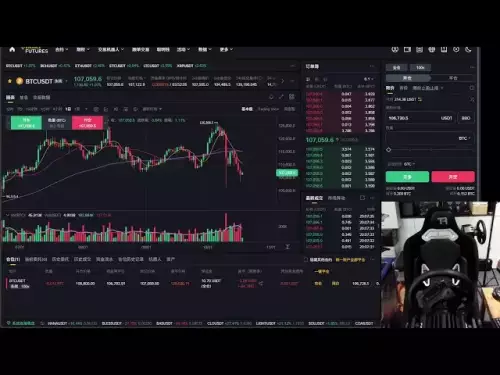-
 bitcoin
bitcoin $106975.071866 USD
-0.29% -
 ethereum
ethereum $3871.670850 USD
-0.07% -
 tether
tether $1.000261 USD
-0.01% -
 bnb
bnb $1084.417621 USD
-0.50% -
 xrp
xrp $2.348167 USD
0.82% -
 solana
solana $185.621736 USD
0.45% -
 usd-coin
usd-coin $0.999833 USD
-0.04% -
 tron
tron $0.313423 USD
0.81% -
 dogecoin
dogecoin $0.188856 USD
0.54% -
 cardano
cardano $0.630416 USD
-0.49% -
 hyperliquid
hyperliquid $36.506353 USD
2.24% -
 ethena-usde
ethena-usde $0.999584 USD
-0.01% -
 chainlink
chainlink $16.750026 USD
-0.77% -
 stellar
stellar $0.313373 USD
0.37% -
 bitcoin-cash
bitcoin-cash $465.978560 USD
-1.57%
How to identify the dealer in ADA trading? What are the common methods?
Dealers in ADA trading can be identified through order book analysis, volume monitoring, technical analysis, market sentiment observation, and trading platform tools.
Apr 29, 2025 at 07:29 am

Introduction to Identifying Dealers in ADA Trading
In the world of cryptocurrency trading, particularly with Cardano (ADA), understanding the role of dealers is crucial for any trader looking to navigate the market effectively. Dealers, often referred to as market makers, play a significant role in providing liquidity and setting prices. Identifying these dealers can give traders insights into market movements and potential trading opportunities. This article will explore the common methods used to identify dealers in ADA trading, providing detailed guidance on how to spot them and understand their impact on the market.
Understanding the Role of Dealers in ADA Trading
Before diving into the methods of identification, it's essential to understand what dealers do in the context of ADA trading. Dealers are entities or individuals that buy and sell ADA, often in large volumes, to ensure there is enough liquidity in the market. They profit from the spread between the buying and selling prices. Their presence can significantly influence the price and volume of ADA, making it important for traders to recognize their activities.
Method 1: Analyzing Order Book Data
One of the primary methods to identify dealers in ADA trading is by analyzing the order book data. The order book provides a real-time list of buy and sell orders for ADA, showing the depth of the market.
- Look for large orders: Dealers often place large orders to influence the market. These orders can be seen at the top of the order book, either as bids or asks.
- Observe order patterns: Dealers may place and cancel orders frequently to manipulate the market perception of liquidity. Look for patterns where large orders are placed and then quickly removed.
- Check for order book imbalances: A significant imbalance between buy and sell orders can indicate dealer activity, as they might be trying to push the price in a particular direction.
Method 2: Monitoring Trading Volume
Another effective way to identify dealers is by monitoring the trading volume of ADA. Dealers typically engage in high-volume trading, which can be observed through volume spikes.
- Identify volume spikes: Sudden increases in trading volume can indicate dealer activity, especially if these spikes occur without significant news or events.
- Analyze volume distribution: Look at how volume is distributed across different price levels. Dealers might concentrate their trades at specific price points to influence the market.
- Compare volume to market trends: If the volume of ADA trades is significantly higher than the average during certain periods, it could be a sign of dealer involvement.
Method 3: Using Technical Analysis
Technical analysis can also help in identifying dealers in ADA trading. By studying price charts and indicators, traders can spot patterns that suggest dealer activity.
- Look for price manipulation patterns: Dealers might engage in practices like spoofing or layering, which can be detected through unusual price movements.
- Use indicators like the Volume Weighted Average Price (VWAP): VWAP can help identify whether large trades are influencing the average price, which could be a sign of dealer activity.
- Analyze candlestick patterns: Certain candlestick patterns, such as long wicks or doji candles, can indicate dealer attempts to manipulate the market.
Method 4: Observing Market Sentiment
Market sentiment can provide clues about dealer activity in ADA trading. By monitoring social media, forums, and other platforms, traders can gauge the overall sentiment and identify potential dealer influence.
- Track sentiment shifts: Sudden changes in market sentiment, especially without clear reasons, can indicate dealer manipulation.
- Monitor social media activity: Dealers might use social media to spread rumors or misinformation to influence market sentiment.
- Analyze sentiment indicators: Tools like the Fear and Greed Index can help identify whether sentiment is being manipulated by dealers.
Method 5: Utilizing Trading Platforms and Tools
Various trading platforms and tools offer features that can help identify dealers in ADA trading. These tools can provide detailed data and analysis that might not be available through standard market data.
- Use advanced order book analysis tools: Some platforms offer tools that can highlight large orders and order patterns more effectively.
- Leverage trading algorithms: Algorithms can be programmed to detect dealer activity based on specific criteria, such as volume and price movements.
- Subscribe to market data services: Services that provide real-time data and analysis can help traders spot dealer activity more easily.
Frequently Asked Questions
Q1: Can dealers manipulate the ADA market?Yes, dealers can manipulate the ADA market through various techniques like spoofing, layering, and spreading misinformation. However, regulatory bodies and exchanges are increasingly vigilant about such activities and take measures to prevent them.
Q2: How can I protect myself from dealer manipulation in ADA trading?To protect yourself from dealer manipulation, it's essential to use multiple sources of information, rely on technical analysis, and avoid making impulsive trading decisions based on sudden market movements. Additionally, using stop-loss orders can help mitigate potential losses.
Q3: Are there any legal implications for dealers manipulating the ADA market?Yes, manipulating the market is illegal in many jurisdictions. Dealers found engaging in such activities can face severe penalties, including fines and imprisonment. Exchanges and regulatory bodies work to identify and prosecute such cases.
Q4: Can small traders benefit from identifying dealers in ADA trading?Yes, small traders can benefit from identifying dealers by understanding market dynamics better and making more informed trading decisions. By recognizing dealer activity, traders can anticipate potential price movements and adjust their strategies accordingly.
Disclaimer:info@kdj.com
The information provided is not trading advice. kdj.com does not assume any responsibility for any investments made based on the information provided in this article. Cryptocurrencies are highly volatile and it is highly recommended that you invest with caution after thorough research!
If you believe that the content used on this website infringes your copyright, please contact us immediately (info@kdj.com) and we will delete it promptly.
- Dota 2 YouTube Hack: Solana Scam Exposes Esports Security Flaws
- 2025-10-19 18:25:13
- Pumpfun's PUMP Price: Comeback Reasons and What's Next!
- 2025-10-19 18:25:13
- DYDX Hits Annual Lows: Analyst Call Fails to Ignite Rally
- 2025-10-19 18:30:13
- Internet Computer's Bearish Plunge: Is a 52-Week Low the End?
- 2025-10-19 18:30:13
- ENS on the Edge: Bollinger Bands and Bearish Momentum
- 2025-10-19 18:35:12
- ONDO's Wild Ride: Bollinger Bands and Oversold Territory – What's Next?
- 2025-10-19 18:35:12
Related knowledge

Practical parameter settings for a Bitcoin multi-timeframe moving average system
Sep 18,2025 at 10:54pm
Optimizing Timeframe Combinations for Bitcoin Trading1. Selecting appropriate timeframes is crucial when building a multi-timeframe moving average sys...

How can I filter out false breakouts in Dogecoin high-frequency trading?
Sep 22,2025 at 01:00am
Understanding False Breakouts in Dogecoin Trading1. A false breakout occurs when Dogecoin's price appears to move beyond a defined support or resistan...

Techniques for identifying tops and bottoms in the Bitcoin on-chain NVT model
Sep 20,2025 at 07:54pm
Understanding the NVT Model in Bitcoin Analysis1. The Network Value to Transactions (NVT) ratio is often described as the 'P/E ratio' of the cryptocur...

What does the surge in open interest in Bitcoincoin futures mean?
Sep 20,2025 at 11:18pm
Understanding the Surge in Dogecoin Futures Open Interest1. A surge in open interest within Dogecoin futures indicates a growing number of active cont...

How can I use the Ethereum USDT premium to gauge market sentiment?
Sep 18,2025 at 11:55pm
Understanding the Ethereum USDT Premium1. The Ethereum USDT premium refers to the price difference between USDT (Tether) traded on Ethereum-based plat...

What should I do if Ethereum staking yields decline?
Sep 20,2025 at 06:18am
Understanding the Causes Behind Declining Ethereum Staking Yields1. The Ethereum network transitioned to a proof-of-stake consensus mechanism with the...

Practical parameter settings for a Bitcoin multi-timeframe moving average system
Sep 18,2025 at 10:54pm
Optimizing Timeframe Combinations for Bitcoin Trading1. Selecting appropriate timeframes is crucial when building a multi-timeframe moving average sys...

How can I filter out false breakouts in Dogecoin high-frequency trading?
Sep 22,2025 at 01:00am
Understanding False Breakouts in Dogecoin Trading1. A false breakout occurs when Dogecoin's price appears to move beyond a defined support or resistan...

Techniques for identifying tops and bottoms in the Bitcoin on-chain NVT model
Sep 20,2025 at 07:54pm
Understanding the NVT Model in Bitcoin Analysis1. The Network Value to Transactions (NVT) ratio is often described as the 'P/E ratio' of the cryptocur...

What does the surge in open interest in Bitcoincoin futures mean?
Sep 20,2025 at 11:18pm
Understanding the Surge in Dogecoin Futures Open Interest1. A surge in open interest within Dogecoin futures indicates a growing number of active cont...

How can I use the Ethereum USDT premium to gauge market sentiment?
Sep 18,2025 at 11:55pm
Understanding the Ethereum USDT Premium1. The Ethereum USDT premium refers to the price difference between USDT (Tether) traded on Ethereum-based plat...

What should I do if Ethereum staking yields decline?
Sep 20,2025 at 06:18am
Understanding the Causes Behind Declining Ethereum Staking Yields1. The Ethereum network transitioned to a proof-of-stake consensus mechanism with the...
See all articles





















![[4K 60fps] Astral by oc3andark (1 Coin) [4K 60fps] Astral by oc3andark (1 Coin)](/uploads/2025/10/19/cryptocurrencies-news/videos/k-fps-astral-ocandark-coin/68f438453fa33_image_500_375.webp)




















































